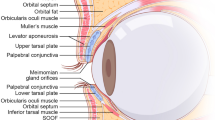Abstract
Background
Autologous fat grafting is a common treatment for tear trough deformities. This procedure involves a potential complication of fat nodule formation, leading to abnormal bulging of the lower eyelid. However, limited information exists about this complication, and an effective treatment is lacking. The present study aimed to present a novel surgical approach for the removal of fat nodules caused by autologous fat grafting in the tear trough.
Methods
This retrospective study included 33 patients who underwent surgery for the removal of fat nodules formed after autologous fat grafting. The procedure was performed using a conjunctival approach, allowing exposure and removal of all fat nodules in the anterior septal space, with the method adapted according to the severity of the deformity.
Results
A total of 66 eyelids were treated surgically, including 30 (45.45%) with mild nodular deformity, 23 (34.85%) with moderate nodular deformity, and 13 (10.70%) with severe nodular deformity. A second surgical procedure was required on 3 eyelids (4.56%). The main complications of the surgery were conjunctival congestion (21.21%), and localized depression (18.18%), bruising (12.12%). Among the patients, 29 (87.88%) were satisfied and 4 (12.12%) were dissatisfied with the treatment results.
Conclusion
Conjunctival approach surgery is an effective method of removing fat nodules formed after autologous fat grafting in the tear trough, with good results and high levels of patient satisfaction. This approach enables the effective management of a common complication of autologous fat grafting and may enable the wider application of autologous fat grafting in the periorbital region.
Level of Evidence III
This journal requires that authors assign a level of evidence to each article. For a full description of these Evidence-Based Medicine ratings, please refer to the Table of Contents or the online Instructions to Authors www.springer.com/00266.





Similar content being viewed by others
References
Coban I, Derin O, Sirinturk S, Pinar Y, Govsa F (2023) Anatomical basis for the lower eyelid rejuvenation. Aesthet Plast Surg 47:1059–1066
Lipp M, Weiss E (2019) Nonsurgical treatments for infraorbital rejuvenation: a review. Dermatol Surg 45:700–710
Attenello NH, Maas CS (2015) Injectable fillers: review of material and properties. Facial Plast Surg 31(1):29–34
Roh MR, Kim TK, Chung KY (2009) Treatment of infraorbital dark circles by autologous fat transplantation: a pilot study. Br J Dermatol 160:1022–1025
Stutman RL, Codner MA (2012) Tear trough deformity: review of anatomy and treatment options. Aesthet Surg J 32:426–440
Corduff N (2020) An alternative periorbital treatment option using calcium hydroxyapatite for hyperpigmentation associated with the tear trough deformity. Plast Reconstr Surg Glob Open 8:e2633
Coleman SR (2008) Long-term survival of fat transplants: controlled demonstrations. Aesthet Plast Surg 44:1268–1272
Shue S, Kurlander DE, Guyuron B (2018) Fat injection: a systematic review of injection volumes by facial subunit. Aesthet Plast Surg 42:1261–1270
Billings E Jr, May JW Jr (1989) Historical review and present status of free fat graft autotransplantation in plastic and reconstructive surgery. Plast Reconstr Surg 83:368–381
Ciuci PM, Obagi S (2008) Rejuvenation of the periorbital complex with autologous fat transfer: current therapy. J Oral Maxillofac Surg 66:1686–1693
Feinendegen DL, Baumgartner RW, Vuadens P et al (1998) Autologous fat injection for soft tissue augmentation in the face: a safe procedure. Aesthet Plast Surg 22:163–167
Yoon SS, Chang DI, Chung KC (2003) Acute fatal stroke immediately following autologous fat injection into the face. Neurology 61:1151–1152
Lam SM, Glasgold RA, Glasgold MJ (2008) Limitations, complications, and long-term sequelae of fat transfer. Facial Plast Surg Clin North Am 16:391–399
Maamari RN, Massry GG, Holds JB (2019) Complications associated with fat grafting to the lower eyelid. Facial Plast Surg Clin North Am 27:435–441
Cuzalina A, Guerrero AV (2018) Complications in fat grafting. Atlas Oral Maxillofac Surg Clin North Am 26:77–80
Mashiko T, Yoshimura K (2015) How does fat survive and remodel after grafting. Clin Plast Surg 42:181–190
Kranendonk S, Obagi S (2007) Autologous fat transfer for periorbital rejuvenation: indications, technique, and complications. Dermatol Surg 33:572–578
Bellini E, Grieco MP, Raposio E (2017) The science behind autologous fat grafting. Ann Med Surg (Lond) 24:65–73
Funding
The authors received no financial support for the research, authorship, and publication of this article.
Author information
Authors and Affiliations
Contributions
ZL and ZZ contributed equally to this work. LX developed the idea and provided the data for the study. ZL and ZZ analyzed the data and wrote the paper. Other co-authors collect literature and polish the paper.
Corresponding author
Ethics declarations
Conflict of interest
The authors have no financial interest to declare in relation to the content of this article.
Human and Animal Rights
The ethical principles outlined in the Declaration of Helsinki were followed.
Patient Consent on File
Consent for the publication of recognizable patient photographs or other identifiable material was obtained by the authors and included at the time of article submission to the journal stating that the patients gave consent with the understanding that this information may be publicly available.
Additional information
Publisher's Note
Springer Nature remains neutral with regard to jurisdictional claims in published maps and institutional affiliations.
Supplementary Information
Below is the link to the electronic supplementary material.
Supplementary file1 (MP4 126228 kb)
Rights and permissions
Springer Nature or its licensor (e.g. a society or other partner) holds exclusive rights to this article under a publishing agreement with the author(s) or other rightsholder(s); author self-archiving of the accepted manuscript version of this article is solely governed by the terms of such publishing agreement and applicable law.
About this article
Cite this article
Li, Z., Zhang, Z., Ma, T. et al. Surgical Removal of Fat Nodules Formed in the Tear Trough After Autologous Fat Grafting. Aesth Plast Surg (2024). https://doi.org/10.1007/s00266-024-04057-3
Received:
Accepted:
Published:
DOI: https://doi.org/10.1007/s00266-024-04057-3




